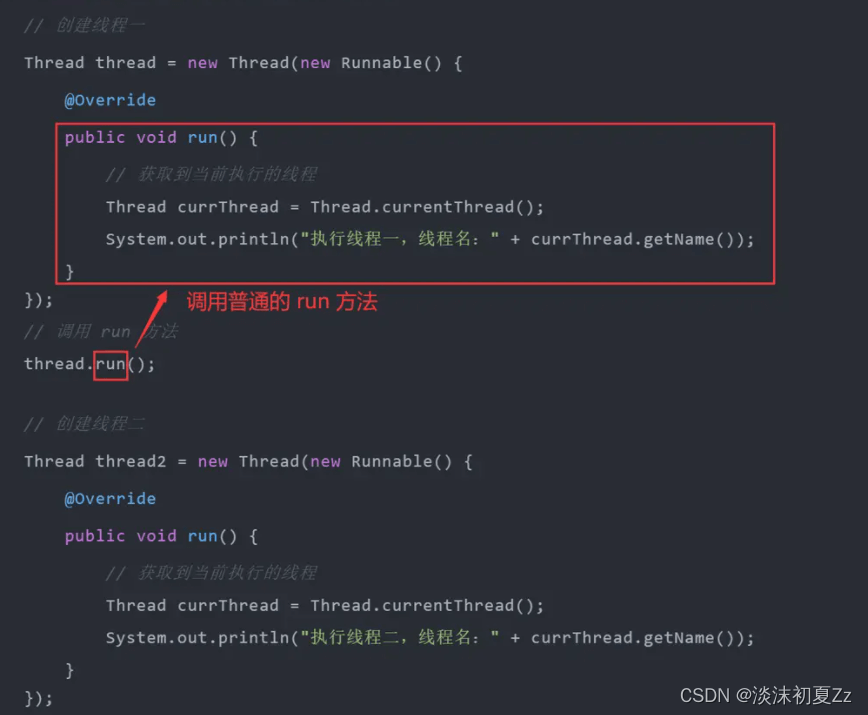通过覆写 run 方法创建⼀个线程对象,但线程对象被创建出来并不意味着线程就开始运行了
继承Thread类
/**
* 继承Thread创建线程
*/
class MyThread1 extends Thread{
@Override
public void run() {
//业务代码
Thread thread = Thread.currentThread();
System.out.println("名称:" + thread.getName());
}
}
public class ThreadDemo1 {
public static void main(String[] args) {
//获得当前的线程
Thread mainThread = Thread.currentThread();
System.out.println("名称:" + mainThread.getName());
Thread thread = new MyThread1();
//开启线程
thread.start();
}
}因为 Java 是单继承,继承了 Thread 就不能继承其他类了,然而 Java 可以实现多个接口,于是有了下⼀种方式
实现Runnable接口
/**
* 使用Runnable接口创建线程
*/
class MyThread2 implements Runnable{
@Override
public void run() {
Thread thread = Thread.currentThread();//得到当前线程
System.out.println("名称:" + thread.getName());
}
}
public class ThreadDemo2 {
public static void main(String[] args) {
MyThread2 myThread2 = new MyThread2();
//创建线程
Thread thread = new Thread(myThread2);
//启动线程
thread.start();
}
}继承Thread类使用匿名内部类
/**
* 继承Thread使用匿名内部类创建
*/
public class ThreadDemo4 {
public static void main(String[] args) {
Thread thread = new Thread(){
@Override
public void run() {
// 业务代码
Thread thread2 = Thread.currentThread();
System.out.println("名称" + thread2.getName());
}
};
//开始线程
thread.start();
}
}实现Runnable接口,使用匿名内部类
/**
* runnable使用匿名内部类创建
*/
public class ThreadDemo3 {
public static void main(String[] args) {
Thread thread = new Thread(new Runnable() {
@Override
public void run() {
//具体业务
Thread thread1 = Thread.currentThread();
System.out.println("名称:" + thread1.getName());
}
});
//开启线程
thread.start();
}
}使用lambda表达式
/**
* 使用lambda表达式
*/
public class ThreadDemo5 {
public static void main(String[] args) {
//创建线程
Thread thread = new Thread(()->{
//业务代码
Thread thread3 = Thread.currentThread();
System.out.println("名称" + thread3.getName());
});
//启动线程
thread.start();
}
}带返回值的 Callable
import java.util.Random;
import java.util.concurrent.Callable;
import java.util.concurrent.ExecutionException;
import java.util.concurrent.FutureTask;
/**
* 使用callable创建线程
*/
public class ThreadDemo6 {
public static void main(String[] args)throws ExecutionException, InterruptedException {
// 创建 Callable 实例
MyCallable callable = new MyCallable();
// 用于接收 Callable 结果的对象
FutureTask<Integer> futureTask = new FutureTask<Integer>(callable);
// 创建新线程
Thread thread = new Thread(futureTask);
// 启动线程
thread.start();
// 接收新线程执行的结果
int result = futureTask.get();
System.out.println(Thread.currentThread().getName() +
"——新线程返回的结果为:" + result);
}
}
/**
* Callable<V> 泛型里面可以是任意数据类型
*/
class MyCallable implements Callable<Integer> {
@Override
public Integer call() throws Exception {
// 生成随机数:0-9
int randomNum = new Random().nextInt(10);
System.out.println(Thread.currentThread().getName() +
"——随机数:" + randomNum);
return randomNum;
}
}在创建线程时, 如果是 JDK 1.8 以上版本,在不需要获得线程执行结果的情况下,推荐使用Lambda 方式来创建线程,因为它的写法足够简洁;如果想要获取线程执行结果,可使用FutureTask + Callable 的方式来实现
run 方法和 start 方法的主要区别如下:
run 是一个普通方法,而 start 是开启新线程的方法。

调用 run 方法会立即执行任务,调用 start 方法是将线程的状态改为就绪状态,不会立即执行。
run 方法可以被重复调用,而 start 方法只能被调用一次。start 方法之所以不能被重复调用的原因是,线程的状态是不可逆的,Thread 在 start 的实现源码中做了判断,如果线程不是新建状态 NEW,则会抛出非法线程状态异常IllegalThreadStateException
public static void main(String[] args) {
// 创建线程一
Thread thread = new Thread(new Runnable() {
@Override
public void run() {
// 获取到当前执行的线程
Thread currThread = Thread.currentThread();
System.out.println("执行线程一,线程名:" + currThread.getName());
}
});
// 调用 run 方法
thread.run();
// 多次调用 run 方法
thread.run();
// 创建线程二
Thread thread2 = new Thread(new Runnable() {
@Override
public void run() {
// 获取到当前执行的线程
Thread currThread = Thread.currentThread();
System.out.println("执行线程二,线程名:" + currThread.getName());
}
});
// 调用 start 方法
thread2.start();
// 多次调用 start 方法
thread2.start();
}
从上述结果可以看出,run 方法多次调用可用正常执行,而第二次调用 start 方法时程序就报错了,提示“IllegalThreadStateException”非法线程状态异常
方法性质不同:run 是一个普通方法,而 start 是开启新线程的方法。
执行速度不同:调用 run 方法会立即执行任务,调用 start 方法是将线程的状态改为就绪状态,不会立即执行。
调用次数不同:run 方法可以被重复调用,而 start 方法只能被调用一次。

1、Thread()创建线程
Thread t1 = new Thread();
2、Thread(Runnable target) 创建线程
Thread t2 = new Thread(new MyRunnable());
3、Thread(String name)创建线程且命名
/**
* 创建线程,构造方法设置线程名称
*/
public class ThreadDemo9 {
public static void main(String[] args) {
//构造方法设置名称
Thread thread = new Thread("线程1"){
@Override
public void run() {
//休眠线程
try {
Thread.sleep(1000*60*60);
} catch (InterruptedException e) {
e.printStackTrace();
}
}
};
thread.start();
}
}4、Thread(Runnable target, String name),用Runnable 对象创建线程对象,并命名
/**
* 创建线程,并设置名称
*/
public class ThreadDemo10 {
public static void main(String[] args) {
Thread thread = new Thread(new Runnable() {
@Override
public void run() {
try {
Thread.sleep(1000*60*60);
} catch (InterruptedException e) {
e.printStackTrace();
}
}
},"Runable-Thread");
thread.start();
}
}